Don't wanna be here? Send us removal request.
Text
4th Assignment
- univariate bar graph for categorical variable

first i add libraries for visualize , then visualize 'TAB12MDX' where show Nicotine Dependence in the Past 12 Months Among Young Adult Smokers (0 represent not dependence , 1 represent dependence on nicotine ).
Univariate histogram for quantitative variables :
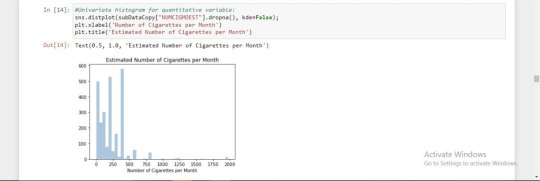
here histogram show number of cigarettes per month using variable "NUMCIGMOEST".

and here show histogram for 'AGE'

describe number of cigarettes smoked per month where mean: 229.5 , count : 2588, min : 2.5 , max : 1980 , std : 216.9 , median : 200 .

here : counts for 'NUMCIGMOEST' and describe AGE where mean : 24.3 , std 3.4 , min : 19 , counts :2591 , median : 24 , max : 30.
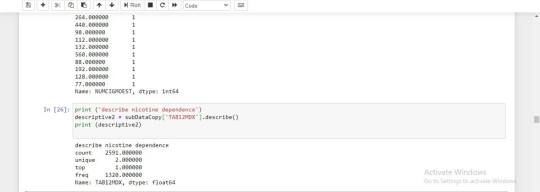
describe nicotine dependence where count : 2591 ,unique : 2 , top : 1 freq : 1320.

here i made a secondary variable is 'PACKSPERMONTH' and show counts and cut into 5 category.

first change format to category then show counts for 5 category and describe Packs where count is 2588 , unique : 5 , top: (0, 5) , freq : 889.
- bivariate bar graph
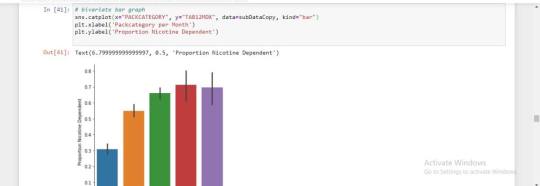
this show packcategory per month with proportion nicotine dependent where Proportion Nicotine Dependent of first category (0-5) of is 0.3 and second category (5-10) is almost 0.6 and so on.
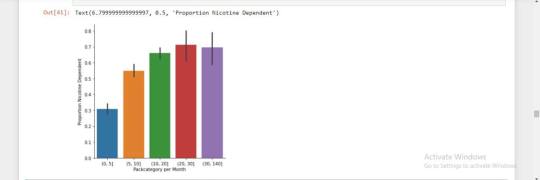
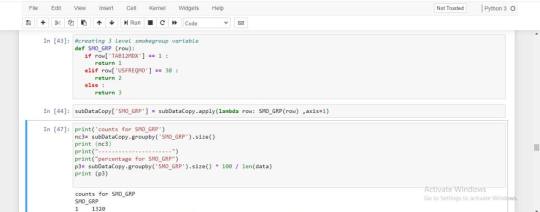
create 3 level smoke_group variable and show counts and percentage.

and creating daily smoking variable ,show counts.
in cell[71]: change the variable format to categorical and create a new variable (PACKCAT) that has the new variable value labels.
bivariate bar graph


show Ethnic Group with Proportion Daily Smokers where Proportion Daily Smokers of White is almost 0.6 , Black is almost 0.9 and NatAm is the same.
0 notes
Text
3rd Assignment
First subset data From ( 19 to 30 ) who have smoked in the past 12 months then recode missing values to NaN , note that there are 3 NaN.
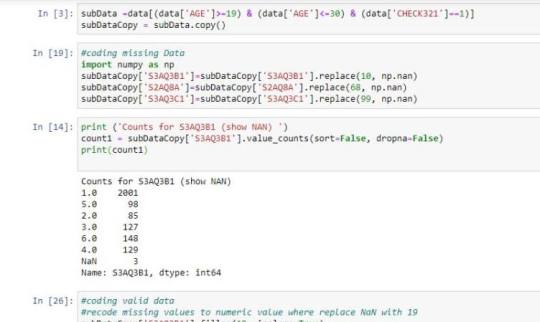
coding valid data :
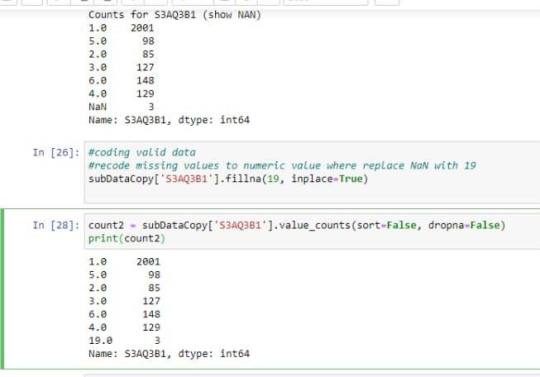
i use 'fillna' to replace NaN with 19 , notice that output of NaN has disappeared.
recode missing values for 'S3AQ3B1' and recoding new variables for 'S3AQ3B1'

secondary variable where multiply the number of days smoked/month and the approximation number of cig. smoked/day
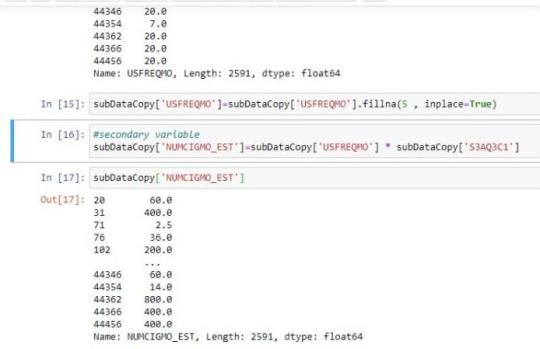
i use 'fillna' before multiply to change NaN to numeric value (5).
Frequency Distribution

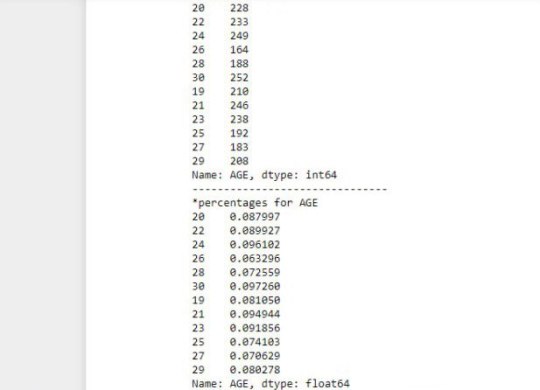
where show counts and percentage for age.

here i split age into 4 groups (17 , 20) , (20 , 22) , (22 , 25 ) , (25 , 29) and show Counts , percentage (frequency distribution).
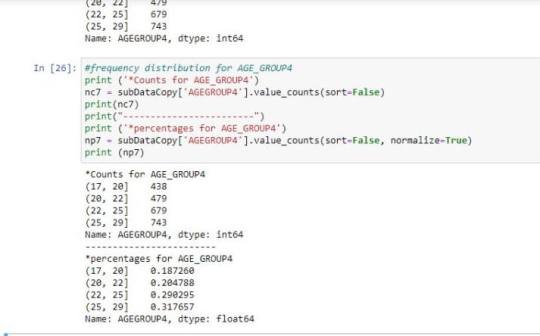
and show frequency distribution for 'S3AQ3C1'
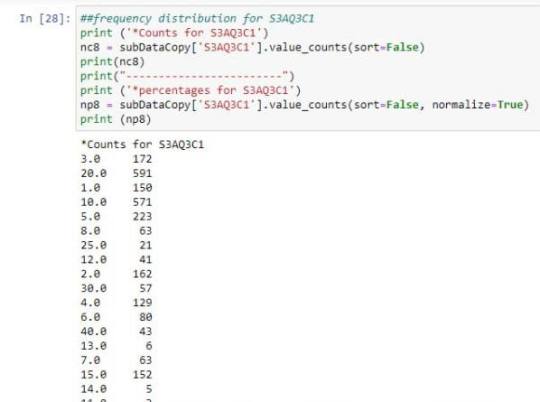
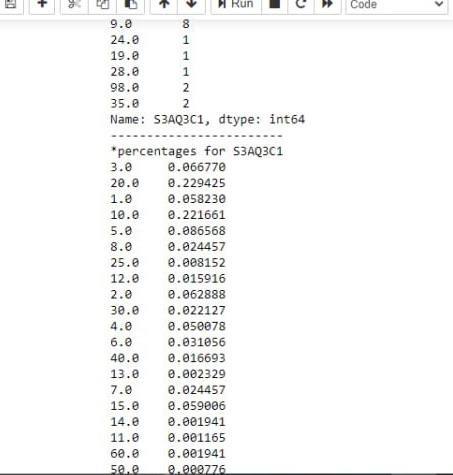
where nc8 show counts for 'S3AQ3C1' and np8 show percentage (frequency dist.)
0 notes
Text
2nd Assignment
Runing my first program , I've choose programming on python.
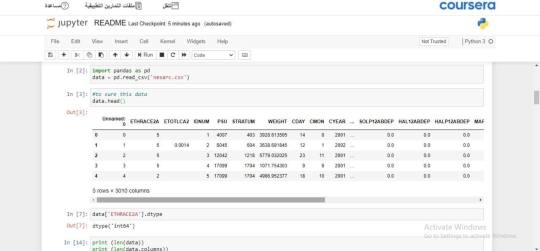
Runing frequency distribution for my 3 variables , select rows & columns.
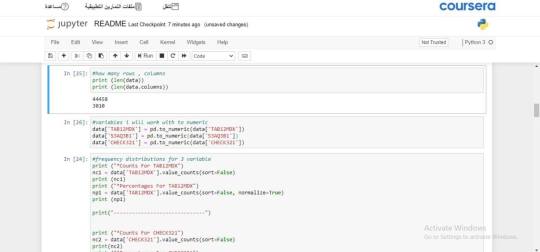
and here i selected variables i would work to numeric.

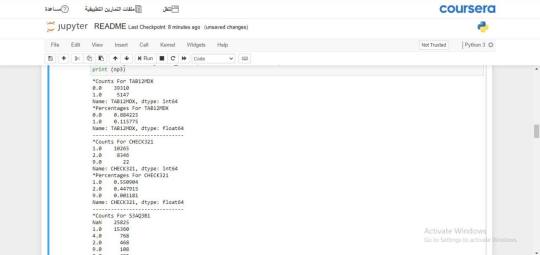

Here we see that 39310 or 88.4 % of 'TAB12MDX' do not meet criteria for nicotine dependence in the past 12 months, while 5147 or 11.5 % of 'TAB12MDX' do meet criteria for nicotine dependence in the past 12 months and the missing value only is one while missing value For 'S3AQ3B1' is 25825.
I use another way to frequency distribution using 'groupby'


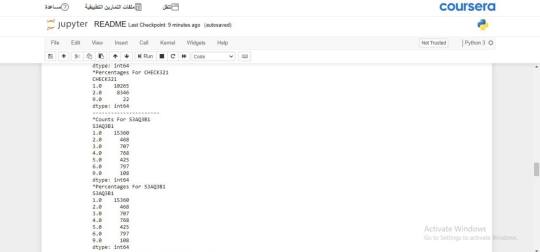
0 notes
Text
First Assignment
i choose data set (NESARC)
i choose this topic ( nicotine dependence )
i interested in exploring the association between smoking behavior and nicotine dependence
whether two topics are associated with one another ?
I believe that they are positively associated.
That is to say: the more an individual smokes, the more likely they are to be nicotine-dependent.
how much a person needs to smoke in order to be nicotine dependent ?
i continue to read through the NESARC code book and find that smoking behavior has also been measured in this sample. So, I take a step similar to one that I just took when choosing nicotine dependence. That is, identify the variables that measure the second topic(smoking behavior).
Research Question :
What are the long-term effects of nicotine dependence on physical and mental health, and what strategies can be effective in preventing and treating nicotine addiction ?
Hypothesis:
Individuals who begin using nicotine at an early age are more likely to develop nicotine dependence compared to those who start later in life.
NESARC Codebook Variables:
variables related to Nicotine Dependence: life-time nicotine dependence and nicotine dependence in the past 12 months.
variables that measure the second topic(smoking behavior):
cigarette smoking status, usual frequency, and usual quantity.
Literature Review :
Nicotine dependence is a complex condition that plays a crucial role in smoking behavior. Understanding the relationship between nicotine dependence and smoking behavior is essential for developing effective prevention and cessation strategies. This literature review aims to explore the current research surrounding nicotine dependence and its impact on smoking behavior.
Results:
Relationship between nicotine dependence and smoking initiation:
Several studies have shown that individuals who develop nicotine dependence are more likely to initiate smoking at an earlier age.
Nicotine dependence is a significant predictor of continued smoking behavior and progression to regular, heavy smoking.
References:
Fiore, M.C., Jaén, C.R., Baker, T.B., et al. (2008). Treating Tobacco Use and Dependence: 2008 Update. Clinical Practice Guideline. Rockville, MD: U.S. Department of Health and Human Services, Public Health Service. This guideline provides evidence-based recommendations for the treatment of tobacco use and dependence, including nicotine addiction.
Benowitz, N.L. (2010). Nicotine Addiction. New England Journal of Medicine, 362(24), 2295-2303. This review article discusses the pharmacology of nicotine, mechanisms of addiction, and the health consequences of nicotine dependence.
Hughes, J.R. (2014). Effects of abstinence from tobacco: Valid symptoms and time course. Nicotine & Tobacco Research, 16(9), 1150-1158. This study examines the withdrawal symptoms experienced during nicotine abstinence and the time course of these symptoms.
Breslau, N., Peterson, E.L., Schultz, L.R., et al. (1998). Are smoking trajectories during the teen years predictors of smoking cessation in adulthood? American Journal of Public Health, 88(6), 852-856. This longitudinal study explores the relationship between smoking patterns during adolescence and the likelihood of smoking cessation in adulthood.
DiFranza, J.R., Savageau, J.A., Fletcher, K., et al. (2002). Symptoms of tobacco dependence after brief intermittent use: The Development and Assessment of Nicotine Dependence in Youth-2 study. Archives of Pediatrics & Adolescent Medicine, 156(4), 438-445. This study investigates the symptoms of nicotine dependence in adolescents who have engaged in intermittent smoking.
Lerman, C., Audrain, J., Orleans, C.T., et al. (1996). Investigation of mechanisms linking depressed mood to nicotine dependence. Addictive Behaviors, 21(1), 9-19. This research examines the mechanisms that may underlie the association between depressed mood and nicotine dependence.
Hatsukami, D.K., Stead, L.F., Gupta, P.C. (2008). Tobacco addiction. The Lancet, 371(9629), 2027-2038. This comprehensive review discusses various aspects of tobacco addiction, including nicotine dependence, treatment options, and public health implications.
1 note
·
View note